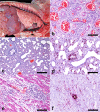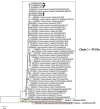A putative PCV3-associated disease in piglets from Southern Brazil
- PMID: 34988935
- PMCID: PMC8882493
- DOI: 10.1007/s42770-021-00644-7
A putative PCV3-associated disease in piglets from Southern Brazil
Abstract
Porcine circovirus type 3 (PCV3) is widely distributed worldwide, and its association with clinical disease in pigs has been studied in recent years. This study describes a novel PCV3-associated clinical disease in piglets from Brazil. Since September 2020, we received 48 piglets with large caudally rotated ears, weakness, and dyspnea. Most piglets were from gilts and died 1-5 days after birth. Two piglets that presented similar clinical signs and survived until 35-60 days had a marked decrease in growth rate. At post-mortem examination, the lungs did not collapse due to marked interlobular edema. Microscopically, the main feature was multisystemic vasculitis characterized by lymphocytes and plasma cells infiltrating and disrupting the wall of vessels, lymphohistiocytic interstitial pneumonia, myocarditis, and encephalitis. Viral replication was confirmed in these lesions through in situ hybridization (ISH-RNA). Seventeen cases were positive for PCV3 in PCR analysis, and all samples tested negative for porcine circovirus (PCV1, and PCV2); porcine parvovirus (PPV1, 2, 5, and 6); atypical porcine pestivirus (APPV); porcine reproductive and respiratory syndrome (PRRSV); and ovine herpesvirus-2 (OvHV-2). Phylogenetic analysis of the ORF2 sequence from five different pig farms showed that the PCV3a clade is circulating among Brazil's swineherds and causing neonatal piglet losses. This is the first report of PCV3a-associated disease in neonatal pigs from farms in Brazil.
Keywords: Diagnosis; Diseases of swine; Dyspnea; Infectious diseases; PCV3; Vasculitis.
© 2021. Sociedade Brasileira de Microbiologia.
Conflict of interest statement
The authors declare no competing interests.
Figures



References
-
- Biagini P, Bendinelli M, Hino S, Kakkola L, Mankertz A, Niel C, Okamoto H, Raidal S, Teo CG, m Todd D. Family Circoviridae. In: King AMQ, Adams MJ, Carstens EB, Lefkowitz EJ, editors. Virus taxonomy: classification and nomenclature of viruses: ninth report of the International Committee on Taxonomy of Viruses. London: Academic Press; 2012. pp. 343–349.
MeSH terms
Grants and funding
LinkOut - more resources
Full Text Sources

